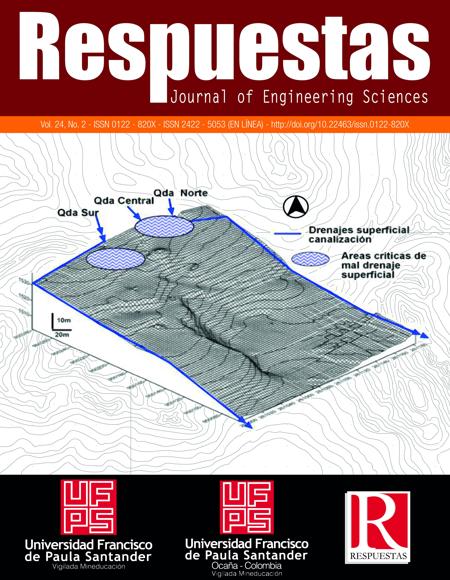Modeling and simulation of an electrolyser for the production of HHO in Matlab- Simulink®
Modelamiento y simulación de un electrolizador para la producción de HHO en Matlab-Simulink®
Main Article Content
The electrolyzers work through an electrochemical process, their derivatives (H2,O2 , and HHO) are used as enriching fuels due to the electrolysis of water, being cleaner than gasoline and diesel. This article presents the dynamic model of an alkaline electrolyzer that uses an electrolyte ( KOH o NaHCO3) dissolved in distilled water to accelerate the production of oxyhydrogen (HHO). The model shows the phase change that occurs inside the electrolytic cell. The EES® software was used to determine the values of enthalpy, entropy, and free energy that vary during the electrochemical reaction; the equations were simulated in Matlab-Simulink® to observe their dynamic behavior. The Simulations presented varying every 5 g the electrolyte until reaching 20 g. The flow rate of HHO with potassium hydroxide (20 g) is higher than 0.02 L / s, and with sodium bicarbonate (20 g) it is above 0.0006 L / s, confirming what the literature of alkaline cells state, that the most efficient electrolyte for its energy conversion is KOH.
Downloads
Article Details
E. D. Rincón, J. J. García, and J. R. Bermúdez, “ESTADO DEL ARTE DE LAS CELDAS DE COMBUSTIBLE,” Rev. Colomb. Tecnol. Av. Recib., vol. 1, no. 33, pp. 36–49, 2019.
P. L. Cabot, F. Alcaide, and E. Brillas, “Applications - Stationary | Cogeneration of Energy and Chemicals: Fuel Cells,” Ref. Modul. Chem. Mol. Sci. Chem. Eng., pp. 146–156, 2013.
J. Alvarado, “Estudio comparativo de las diferentes tecnologías de celdas de combustible,” Bol. la Soc. Española Cerámica y Vidr., vol. 52, no. 3, pp. 105–117, 2013.
Á. O. Díaz, J. E. González, and O. A. González, “Análisis de un generador de HHO de celda seca para su aplicación en motores de combustión interna,” Rev. UIS Ing., vol. 17, no. 1, pp. 143–154, 2018.
W. Osorio and Ó. H. Giraldo, “Sobre la termodinámica de las soluciones electrolíticas,” Rev. Fac. Ing. Univ. Antioquia, vol. 40, pp. 7–21, 2007.
R. Battino, “Comments on the teaching of chemistry, doing chemistry demonstrations, and a passion for chemical thermodynamics,” J. Chem. Thermodyn., vol. 123, pp. 74–78, 2018.
M. L. Lladó and A. H. Jubert, “Trabajo útil y su relación con la variación de energía de Gibbs,” Educ. Quim., vol. 22, no. 3, pp. 271–276, 2011.
T. Wilberforce et al., “Modelling and simulation of Proton Exchange Membrane fuel cell with serpentine bipolar plate using MATLAB,” Int. J. Hydrogen Energy, vol. 42, no. 40, pp. 25639–25662, 2017.
M. M. De Souza, R. S. Gomes, and A. L. De Bortoli, “A model for direct ethanol fuel cells considering variations in the concentration of the species,” Int. J. Hydrogen Energy, vol. 43, no. 29, pp. 13475–13488, 2018.
O. Ulleberg, “Modeling of advanced alkaline electrolyzers: a system simulation approach,” Int. J. Hydrogen Energy, vol. 28, pp. 21–33, 2003.
A. Ursúa and P. Sanchis, “Static-dynamic modelling of the electrical behaviour of a commercial advanced alkaline water electrolyser,” Int. J. Hydrogen Energy, vol. 37, no. 24, pp. 18598–18614, 2012.
M. Sánchez, E. Amores, L. Rodríguez, and C. Clemente-Jul, “Modelado y simulación de sistemas de producción de hidrógeno vía electrolisis alcalina a partir de energías renovables,” in Congreso Iberoamericano de Hidrógeno y Pilas de Combustible 2017, 2017, pp. 183–186.
G. Yan et al., “An Arrhenius equation-based model to predict the residual stress relief of post weld heat treatment of Ti-6Al-4V plate,” J. Manuf. Process., vol. 32, pp. 763–772, 2018.
D. Michel, “Test of the formal basis of Arrhenius law with heat capacities,” Phys. A Stat. Mech. its Appl., vol. 510, pp. 188–199, 2018.
K. Naveršnik and R. Jurečič, “Humidity-corrected Arrhenius equation: The reference condition approach,” Int. J. Pharm., vol. 500, no. 1–2, pp. 360–365, 2016.
M. Hammoudi, C. Henao, K. Agbossou, Y. Dubé, and M. L. Doumbia, “New multi-physics approach for modelling and design of alkaline electrolyzers,” Int. J. Hydrogen Energy, vol. 37, no. 19, pp. 13895–13913, 2012.







